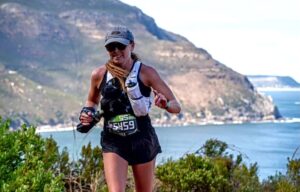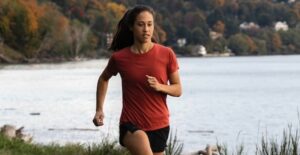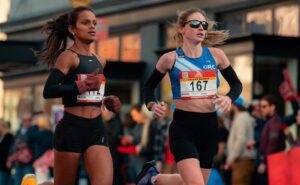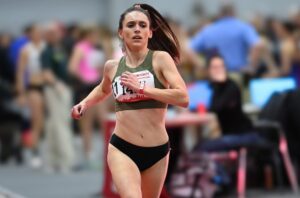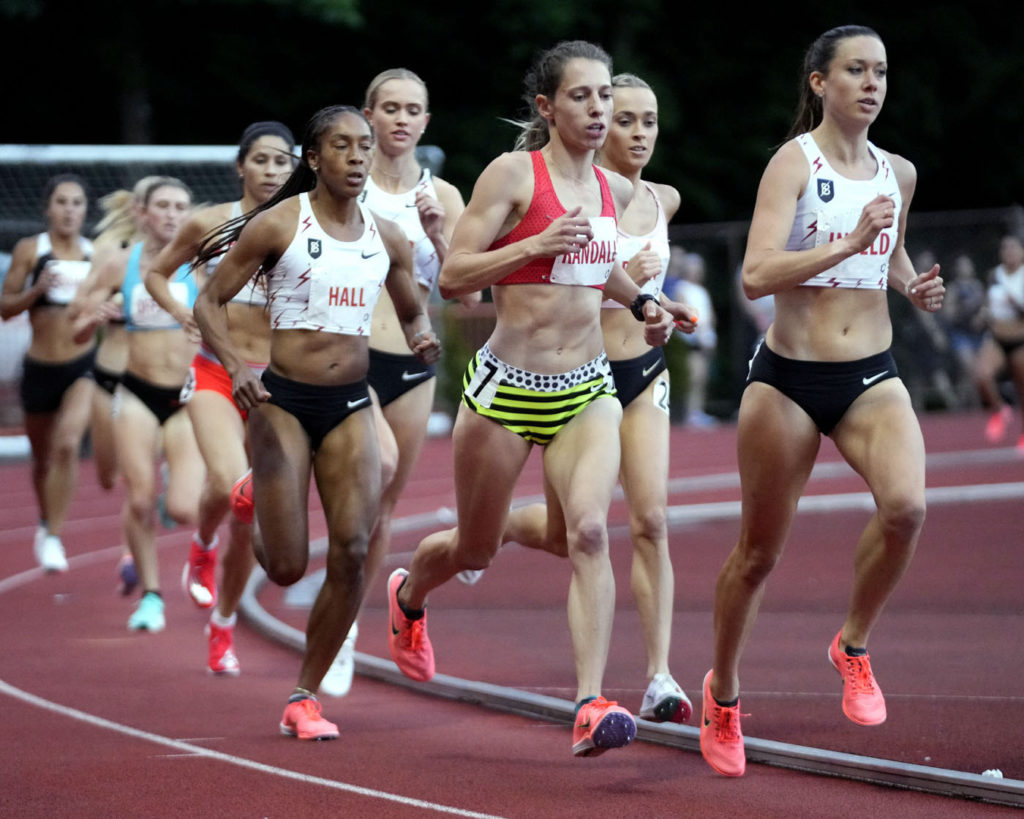
By Alison Wade
In May 2021, Jenn Randall lined up for the “B” heat of the 5,000m at Sound Running’s Track Meet, hoping to break her husband’s 5,000m personal best (16:04). She had to talk her way into the meet, because her 16:28 personal best didn’t put her on the same level as her competitors. But she knew she was fitter than that.
Randall attached herself near the back of a long train of women, paced by Karisa Nelson and Allie Buchalski, and hung on for as long as she could. She surpassed all of her expectations and crossed the finish line in 15:34.64. Qualifying for the Olympic Trials hadn’t been on Randall’s radar, but suddenly she was less than 15 seconds from the 15:20.00 standard.
With the Trials about a month away, she didn’t have long to chase the qualifying time, but she lowered her 5,000m best to 15:30.31, not far off the time needed to earn her a spot on the starting line. Instead of competing at the Trials, Randall, who lives in Eugene, Oregon, where the event was held, volunteered, helping escort athletes to drug testing after their races. She also spectated some of the meet from the stands, including the 5,000m final.
“I was way more invested in [the 5,000m final] because I was thinking, ‘I’m going to be there next time,’” Randall, 30, said.
One month after the Olympic Trials, in July, Randall hit another huge personal best. She lowered her 1500m PR from 4:20.69 to 4:10.82, which would have been only 0.62 seconds away from getting her into the Trials had she run the time earlier in the season.
Randall’s 1500m breakthrough was good news to her, because until then, she was thinking she might have to move up to the 10,000m, the half marathon, or even the marathon, as she saw many runners her age doing. With that one race, she realized she could be nationally competitive in the 1500m as well.
“I was like, ‘Yes! I don’t have to run the 10K!’” she said. “I was super excited because as a former middle distance runner, I love running shorter things.”
Small school background
Growing up in Cincinnatus, New York, population 1,000, Randall was an avid soccer player. She knew from the running she did for other sports that she was pretty fast, but Cincinnatus Central High School didn’t have a track team until her junior year. Randall joined the team, along with one other girl and a handful of boys. The school didn’t have a track, so they practiced on a grass field. Her longest training runs were about three miles.
Randall ran everything from the 100m to the 3,000m. During her senior year, she qualified to run the 1500m at the state meet, where she ran a big personal best of 4:37 and finished ninth behind strong runners like Emily Lipari and Aisling Cuffe.
Randall chose Ithaca College in part because she knew she wanted to study physical therapy, but she also thought Division III athletics sounded right for her. She planned to play soccer in college, but after Ithaca’s cross country coach showed interest, she decided to focus on running instead.
Ithaca’s coaches brought Randall along slowly, gradually increasing her mileage to 30–35 per week over time. She improved steadily, set a handful of school records, and earned three All-America honors by the end of her collegiate career, with a high finish of seventh in the mile at the 2013 NCAA Division III Indoor Track & Field Championships.
“I just had such a great experience in college,” she said. “I was so new to running, the team had a really positive atmosphere, and there was never a ton of pressure put on me to perform. Part of the reason why I still love running so much now, and I don’t feel burnout at all, is that it was just so low-key and fun when I was in college.”
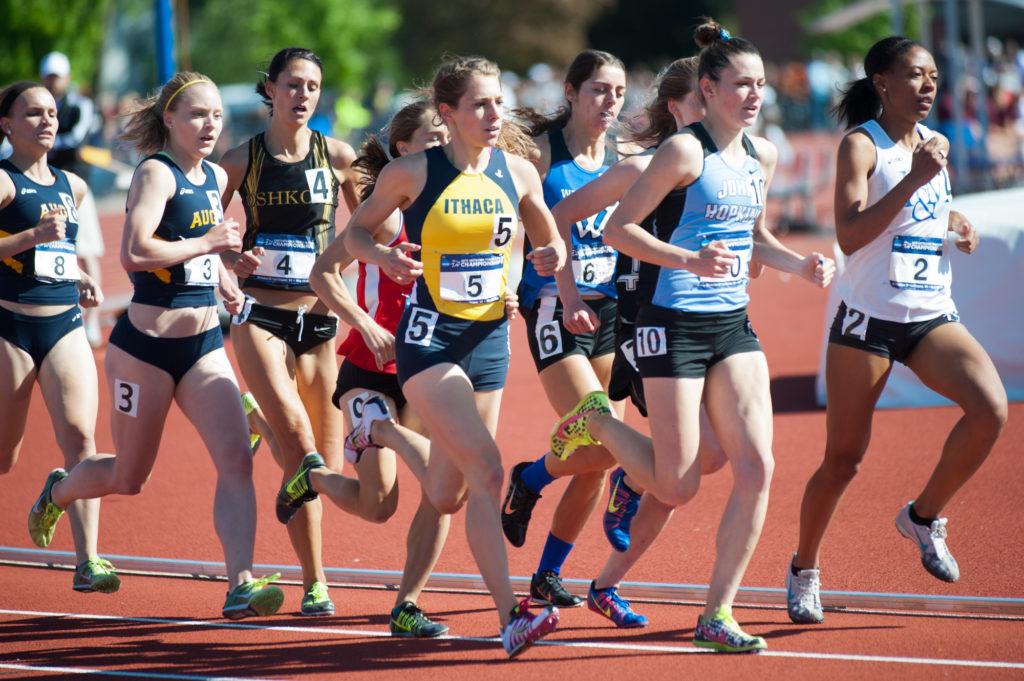
Becoming elite
After college, Randall tried to continue running competitively for a while, but she ended up with a stress fracture. Physical therapy graduate school took up a lot of her time, and after she graduated in 2015, she accepted a job in Eugene, Oregon, where she knew no one.
Randall began running local 5Ks for fun, as a way to meet other runners. A friend whom she met at a community track workout, Peter Stice, offered to help her write some workouts, to give her training more structure. Randall took Stice up on that offer, and he became her coach and eventually her husband.
When they began working together, Randall’s goal was to break 17:00 for 5,000m, which she did in 2019. In 2020, Randall planned to run the Eugene Half Marathon, but the pandemic hit and canceled the race. She was also laid off from her job as a physical therapist for a few months, which created a lot of stress.
“Really what motivated me to train was just like, ‘Okay, this is something I can do that’s in my control and something that makes me happy and makes me feel accomplished,’” she said.
Randall bumped into a high school runner she knew who was looking for some pacing help, which got her excited to work a little harder. She began lifting weights again and putting in much more consistent training. Randall was also motivated by Trials of Miles’ Beat the Heat virtual competition. “I am a super competitive person,” she said. “That tournament motivated me to start to train hard because I didn’t want to lose.” (She ended up winning the competition. And she got her former job back after a few months off.)
Randall gradually worked her way up to the 50–60 miles per week she does most weeks now, and she credits several years of consistent and healthy training for her big jump in ability. She wouldn’t have been able to handle the training she’s doing now when she was in college, but thanks to a gradual progression, she can now. Randall says there’s some luck involved in remaining healthy, too, but her background as a physical therapist helps. “I make smart calls in terms of when to push through something and when to rehab,” she said.
Randall recently joined Cascadia Elite, and though no one on the team is nearby enough to train with, the team offers community and moral support from athletes with similar goals. She squeezes her training into a busy schedule and does most of her workouts alone. Randall arrives at work at 6:45 a.m. and works until 3:00. She either runs right after work or she coaches the youth running club she and Stice founded, and then she gets in her run. Randall does her strength training at home, sometimes while cooking dinner. In some of her remaining time, she fits in classes and mentorship hours for her orthopedic residency program, which will add to her credentials and elevate her physical therapy practice.
In 2020 and early 2021, the lack of races made it difficult for Randall to find the right competitive opportunities. Now that most events are back, the bigger barrier is her work schedule. Because her patients are scheduled one month out, she needs to give at least one month’s notice to get time off from work to race.
Last weekend, Randall ran her first race of 2022, a 3,000m at the University of Washington Invitational in Seattle. She finished second to Eleanor Fulton in 9:02.86, taking 91 seconds off her personal best, set in 2009. In a couple weeks, she’ll go back to UW to race. She can’t run the 3,000m because it’s on a Friday and would conflict with her work, but she expects a big improvement on her 4:53 indoor mile personal best, from 2015.
While Randall can likely run fast enough to get into the USATF Indoor Championships, she’s not likely to have the right racing opportunities before the qualifying window closes. Instead she’s targeting a qualifying mark for the USATF Outdoor Championships, which would give her a chance to race at the new Hayward Field for the first time. “I so badly want to be able to race on that track, and I didn’t get to last year,” she said. “That’s one of my big goals this year, I’m crossing my fingers that I get to race in that awesome stadium.”
At times, competing at this new level feels surreal to Randall. “At the [Stumptown Twilight meet], I was on the line with the Bowerman Babes,” she said. “Emily Infeld, Vanessa Fraser, and Marielle Hall were in my heat, and I think I just looked at my husband like, ‘Oh my gosh, this is happening.’”
But Randall quickly gets past that. “I just try to use that excitement to pull me along adrenaline-wise. I try not to overthink it too much and take it like any other race. I’m just out here to compete and do my best and try not to worry too much about the caliber of people around me. And because I’m kind of new to doing this well, I’m flying under the radar a bit, and I don’t have anything to lose.”
Because of her rapid improvement, Randall is hesitant to set specific time goals. “I think I’m really just getting started, especially with the 1500m, because I’ve barely run it,” she said. “I’d hate to put a number on it because I almost don’t want to limit myself by having a number target. But I really do think I’ve got a lot more potential to run up to in both the 5,000m and the 1500m.”



